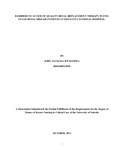| dc.contributor.author | Kwalimwa, John Alumasa | |
| dc.date.accessioned | 2013-04-10T04:57:16Z | |
| dc.date.issued | 2012 | |
| dc.identifier.citation | Master of Science in Nursing(Critical Care) | en |
| dc.identifier.uri | http://erepository.uonbi.ac.ke:8080/xmlui/handle/123456789/15555 | |
| dc.description.abstract | Background: In sub-Saharan Africa, economic and man power factors dictate a conservative approach to RRT but majority of ESRD patients "perish" because of lack of funds. Very few patients can afford regular maintenance hemodialysis and renal transplantation is often not available (Schieppati and Remuzzi, 2005). Kenya has a high number of kidney ailments but acute shortage of kidney specialists with one nephrologist catering for one million people. (Mwaura, 2010).
Study objectives: The study sought to determine the barriers to access of quality renal
replacement therapy in ESRD patients at KNH.
Materials and methods: A quantitative and qualitative descriptive cross-sectional hospital
based study was conducted on KNH ESRD patients over a period of one month, that is June, 2012. Data was collected through administration of questionnaires, information from medical records from respondent's files and key informant interviews. A convenience sample of 108 respondents and purposive sample of 6 medical caregivers was used to select respondents. Qualitative data was coded through content analysis according to themes and quantitative data was analyzed by computer software Statistical Package for Social Sciences (SPSS) version 17.0.
Results and Findings: In the study (98%, n=106) of respondents did not get the minimum
required three hemodialysis sessions per week. Respondents felt doctors (87.9%) and nurses (76%) at the renal unit were not adequate in number. Eighty eight percent of respondents had little or no income thus depend on family contributions to pay for RRT services. There was a strong statistical association between respondents' with low monthly income and missing of dialysis sessions. (Fishers' p = 0.008). There was a significant statistical association between the respondents missing hemodialysis sessions and reported inadequate number of dialysis machines and or high cost of hemodialysis (chi square 1.78 p=0.18). There was a strong statistical significant association between respondents missing hemodialysis sessions and at the same time reported dialysis surgical materials are not always available at KNH pharmacy (Fisher p<O.OOI). Peritoneal dialysis was only acceptable to one respondent (0.93%) and (34%) of the respondents did not have sufficient knowledge on it. Respondents reported that high cost of kidney transplants (42.99%) and kidney donors (51 %) are the two major barriers to this RRT procedure.
Conclusion and Recommendations: ESRD patients at KNH do not have access to quality RRT services. This goes against their constitutional right as stated in the bill of rights, chapter four section 43(1 a) of the constitution of Kenya, "every person has a right to highest attainable health standards and right to health care." The government of Kenya should increase funding to healthcare and fast track decentralization of RR T services to the counties. Kidney transplants should be advocated and made accessible as it is the most effective treatment for ESRD.
Adequate resource allocation and cost containment measures are needed at KNH nephrology department for better management of the ESRD | en |
| dc.language.iso | en | en |
| dc.publisher | University of Nairobi | en |
| dc.title | Barriers to access of quality renal replacement therapy in end-stage renal disease patients at Kenyatta national hospital | en |
| dc.type | Article | en |
| dc.description.department | a
Department of Psychiatry, University of Nairobi, ; bDepartment of Mental Health, School of Medicine,
Moi University, Eldoret, Kenya | |
| local.embargo.terms | 6 months | en |
| local.publisher | School of Nursing | en |

